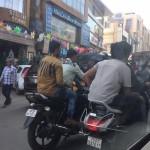On the world’s wildest road trip: India
Published on Michelin Challenge Bibendum online edition January 2016
You barely enter Hyderabad before you feel it: instead of a sense of place you have a sense of roads.
Roads, I have always believed, are meant to lead somewhere, but here the feeling of destination is elusive. Stuff exists alongside roads. Shops, markets, beautiful sites of historical interest all have a constant swarm of vehicles and humanity passing close by, stopping, honking, swerving, crashing, and switching sides of the road as needed. It is colourful and culturally rich, but in the ‘City of Pearls,’ where the Nizams once ruled from spectacular palaces, the motor vehicle is now king.
With a population of around 1.3 billion, India has over four times the inhabitants of the USA. Its average age will be just 29 in 2020. It’s a country with a growing middle class, a country with serious traffic and air quality problems, and a country where the infrastructure can’t keep up with its citizens need for movement. And while the US and Europe reached ‘peak car’ years ago with stable car ownership statistics, India is a country whose car ownership figures are nowhere near their predicted peak.
If you live outside of India and haven’t been, you should go. I’m not just saying that because I love it. For transport or urban planning professionals, India poses some of the most extreme challenges and opportunities in the world. A visceral understanding of them only comes with being there. Its incomparable culture, of course, is a huge bonus.
Hyderabad hosted the 77th Indian Roads Congress annual session last month, a conference for the registered body of road engineers in India. While it isn’t geared towards non-member attendance, I was invited to attend and meet some of our Indian contacts. India’s ‘tech capital,’ with its easily-accessed new airport, was a very cool destination for my first time in India. It happens to be where my father was born and spent his early years while his Welsh parents were stationed there. They also have a wicked-delicious regional biriyani…
At the conference, an excellent talk by Prasanna Desai Architects on smart cities called out the big problems: how streets discourage cycling and walking, how cities are subordinate to cars, the deadly presence of pollution, the difficulty of getting around if you have mobility challenges, etc – and how only good urban planning can fight the madness. It was ambitious and idealistic about the future of Indian city life, and created a flurry of excitement. The talk, with its beautiful computer generated images and focus on sustainability, would be at home in a conference in Belgium or San Fransisco – except the issues it was tackling were on an almost unthinkably huge scale in comparison.
I recognised everything the speaker pointed out. Hyderabad has a population of around 7m, with about 3.3m vehicles on its roads as of 2012, and like many Indian cities, the growing urban population has brought with it a growing numbers of vehicles. It’s often hard to tell where roads begin and end, with paving, dirt and dust becoming indistinguishable and the space for vehicles fading into margins where people chance to walk. Parking, pedestrian area and pedal zone are all the same thing. The driving style and makeup of vehicles on the road is so drastically different from anything you see in Europe – and reflective of such wide socio-economic disparities – it is impossible to describe. Swarms of auto-rickshaws race along within an inch of anything else on the road, be it flesh or metal, spewing plumes of black smoke from two stroke engines. Entire families perch on backs of scooters, usually flouting helmet laws. Executives sit in the back of VIP-style transport, alone but for the driver. They all swerve and dodge along with the hypnotic efficiency of flocking starlings.
An above-ground metro system is under construction as a public-private partnership and promises to transform the city’s commutability when it is eventually commissioned years from now. For now, locals say public transport system is poor. It certainly appears that way; the buses look like they are made of crumbling papier mâché with missing windows and exhaust pipes held on by rope.
Nitin Gadkari, Minister for Road Transport and Highways, gave a well-received address to the conference. It was in Hindi, but thanks to it being peppered with English I could understand some key points. He talked about investing in more sustainable transport, mentioning “EVs” Hybrids” and thrillingly, “electric highways” (what we’re working on at TEV Project). He’s known for an interest in tech.
The engineers I spoke to were full of enthusiasm for the talk. “He gets things done, he hates bureaucracy,” said a retired Chief Engineer of Gadkari. “I agree with him. We need affordable, low emissions forms of transportation that can take the entire population with it, not just the most fortunate.” I think that’s a relatable sentiment for many of us the world over.
So where is India going on its epic road trip? As part of the Brasilia Declaration, India has committed to reducing the number of road accidents and fatalities by 50 % by 2020. It wants to do something about air quality: more than 40,000 premature deaths per year are caused by air pollution from vehicles. As for tackling the sheer quantity and proliferation of motor vehicles, it’s a tall order. Reuters reported the numbers on the roads rose from 50 million in 2003 to 130 million by 2013 (including two and three wheelers). Meanwhile car buyers are getting younger and buying earlier in their careers.
The numbers are so huge, big thinking (like TEV, new urban transport systems, etc) will be required to make any real difference. Thankfully, while India may not have endless funds to improve transport sustainability, it certainly has the talent and will.
Since my wonderful trip to India, one theme has stuck with me: while the scale of challenge is different, the aims are the same. We all have much in common.
Links:
Prasanna Desai Architects
“India struggles to control rising vehicle use, pollution” (Thomson Reuters Foundation)
“Seeing the back of the car” (Economist)
“Car buyers in India getting younger, changing cars more frequently” (Livemint)
“Gadkari: Go hi-tech to ensure quality of roads”





